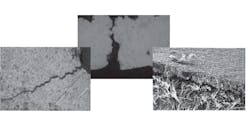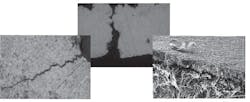Thick Metal Cladding Benefits High-Frequency Laminates
This file type includes high resolution graphics and schematics when applicable.
To solve potentially catastrophic thermal and mechanical failures, high-frequency laminates are often enhanced with a thick metal cladding layer. This layer can be used to harden connector mounting while effectively sinking heat. It also may allow groundplane mounting, increase dimensional stability across the board, and enable robust mounting of the housing fixture. Rogers Corp. offers an application note on the uses of such cladding titled, “Thick Metal Cladding on High Frequency Laminates.”
A high-frequency laminate, such as glass-fiber or ceramic RT/duroid, can be augmented with a thick metal cladding on one side of the board instead of thin copper foil. The thermal conductivity of these substrates is typically between 0.26 and 0.41 Wm-1K-1. Obviously, aluminum metal or alumina with conductivities of 220 and 15.6 Wm-1K-1 could greatly increase the heat dissipated by circuit elements. Additional help in thermally regulating high-heat sites can be gained by mounting diodes, resistors, active elements, and high-current density traces near or directly on the metal cladding.
To avoid alignment problems during assembly, the board can be mechanically strengthened for edge-mounted launchers. It also is advisable to lower the coefficient of thermal expansion (CTE) mismatches between the board and housing. Such approaches will increase both reliability and yield. If the metal for the cladding and the housing are the same, almost all CTE mismatches will be alleviated. Additionally, a thick metal cladding on the board edges permits the use of screw-mounted edge launch connectors, which limit connector strain in the design. Including a thick metal cladding also could reduce the manufacturing issues associated with housing assembly due to board stressing and flexing.
According to the application note, copper, aluminum, and brass are the top choices for thick metal claddings. Aluminum is the most common because it is lightweight and cost effective. Yet it also is the weakest of the common claddings. Brass ranks as the strongest and heaviest with the lowest CTE and thermal-conductivity cladding. The most expensive, thermally conductive, and lowest-resistance cladding is copper.
Rogers Corp., 100 S. Roosevelt Ave., Chandler, AZ 85226, ( 480) 961-4533
This file type includes high resolution graphics and schematics when applicable.
About the Author
Jean-Jacques DeLisle
Jean-Jacques graduated from the Rochester Institute of Technology, where he completed his Master of Science in Electrical Engineering. In his studies, Jean-Jacques focused on Control Systems Design, Mixed-Signal IC Design, and RF Design. His research focus was in smart-sensor platform design for RF connector applications for the telecommunications industry. During his research, Jean-Jacques developed a passion for the field of RF/microwaves and expanded his knowledge by doing R&D for the telecommunications industry.


